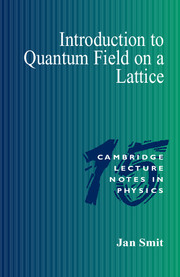Book contents
- Frontmatter
- Contents
- Preface
- 1 Introduction
- 2 Path-integral and lattice regularization
- 3 O(n) models
- 4 Gauge field on the lattice
- 5 U(1) and SU(n) gauge theory
- 6 Fermions on the lattice
- 7 Low-mass hadrons in QCD
- 8 Chiral symmetry
- Appendix A SU(n)
- Appendix B Quantization in the temporal gauge
- Appendix C Fermionic coherent states
- Appendix D Spinor fields
- Notes
- References
- Index
1 - Introduction
Published online by Cambridge University Press: 05 November 2009
- Frontmatter
- Contents
- Preface
- 1 Introduction
- 2 Path-integral and lattice regularization
- 3 O(n) models
- 4 Gauge field on the lattice
- 5 U(1) and SU(n) gauge theory
- 6 Fermions on the lattice
- 7 Low-mass hadrons in QCD
- 8 Chiral symmetry
- Appendix A SU(n)
- Appendix B Quantization in the temporal gauge
- Appendix C Fermionic coherent states
- Appendix D Spinor fields
- Notes
- References
- Index
Summary
We introduce here quarks and gluons. The analogy with electrodynamics at short distances disappears at larger distances with the emergence of the string tension, the force that confines the quarks and gluons permanently into bound states called hadrons.
Subsequently we introduce the simplest relativistic field theory, the classical scalar field.
QED, QCD, and confinement
Quantum electrodynamics (QED) is the quantum theory of photons (γ) and charged particles such as electrons (e±), muons (μ±), protons (p), pions (π±), etc. Typical phenomena that can be described by perturbation theory are Compton scattering (γ + e– → γ + e–), and pair annihilation/production such as e+ + e– → μ+ + μ–. Examples of non-perturbative phenomena are the formation of atoms and molecules. The expansion parameter of perturbation theory is the fine-structure constant α = e2/4π.
Quantum chromodynamics (QCD) is the quantum theory of quarks (q) and gluons (g). The quarks u, d, c, s, t and b (‘up’, ‘down’, ‘charm’, ‘strange’, ‘top’ and ‘bottom’) are analogous to the charged leptons νe, e, νμ, μ, ν, and. In addition to electric charge they also carry ‘color charges’, which are the sources of the gluon fields. The gluons are analogous to photons, except that they are self-interacting because they also carry color charges. The strength of these interactions is measured by αs = g2/4π (alpha strong), with g analogous to the electromagnetic charge e.
- Type
- Chapter
- Information
- Introduction to Quantum Fields on a Lattice , pp. 1 - 7Publisher: Cambridge University PressPrint publication year: 2002

